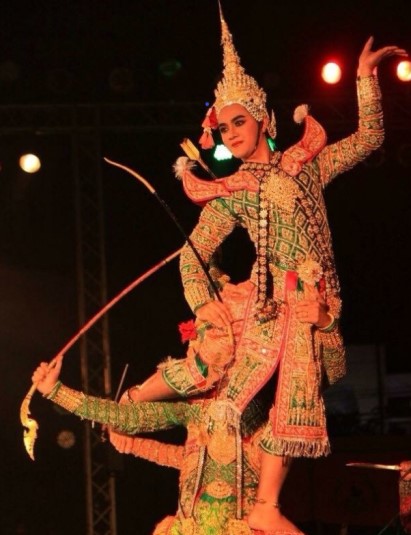Weapon Handling Principles of Khon's Male Protagonist in Ramakien
Keywords:
weapon handling, Khon's male protagonist in RamakienAbstract
“Weapon Handling Principles of Khon's Male Protagonist in Ramakien" aimed to study the origin and types of weapons used as the main prop in Khon performance, as well as the principles and methods of weapon handling found in Ramakien, the Khon performance by the Fine Arts Department. Data was collected from academic documentation, interviews, observation, participation in the training with the national artist who is the expert in male protagonist dance, as well as accumulation of researcher’s personal experience in teaching and performing the role of Khon's male protagonist for more than 17 years at Bunditpatanasilpa Institute, Ministry of Culture.
The results showed that the origin of weapon’s types was derived from Ramakien literature, mural paintings and sculpture of gods according to Hindu beliefs, as well as the imitation of real weapons, recreated to be suitable for Khon performance. The types of weapons can be divided into 3 types: 1.Short-ranged weapons, 2.Long-ranged weapons, 3.Special weapons. The principles of weapon handling were as follows. Weapon holding - consisted of 7 characteristics: 1.Grasping, 2.Pinching, 3.gripping between fingers, 4.Gripping with palms, 5.Pressing in two hands, 6.Holding with Lor Kaew posture, and 7.Holding with Cheeb posture. Weapon handling used in Khon performance consisted of weapon handling in Na Phat dance; weapon handling in fight scene; weapon handling in scripts; weapon handling for carrying purpose; placing, receiving, and passing weapons. This included the styles of holding weapons at various levels and positions, as well as techniques for weapon handling in the dance, which can be used as a guideline for the accurate and beautiful performance.
References
ชวลิต สุนทรานนท์. (ผู้บรรยาย) (20 กันยายน 2556). การละครและดนตรี. กรุงเทพมหานคร: สำนักการสังคีต กรมศิลปากร.
ปกรณ์ พรพิสุทธิ์. (ผู้บรรยาย) (20 กันยายน 2556). นาฏศิลป์ไทยโขนพระ. กรุงเทพมหานคร: สำนักการสังคีต กรมศิลปากร.
ไพฑูรย์ เข้มแข็ง. (ผู้บรรยาย) (20 กันยายน 2556). ด้านนาฏศิลป์ไทย (โขนพระ). กรุงเทพมหานคร: วิทยาลัยนาฏศิลป์ กระทรวงวัฒนธรรม.
มองซิเออร์ เดอ ลาลูแบร์. (2552). ราชอาณาจักรสยาม. พระนคร: สำนักพิมพ์ก้าวหน้า.
วีระชัย มีบ่อทรัพย์. (ผู้บรรยาย.) (20 กันยายน 2561). นาฏศิลป์ไทยโขนพระ. กรุงเทพมหานคร: คณะศิลปศึกษา สถาบันบัณฑิตพัฒนศิลป์.
ศุภชัย จันทร์สุวรรณ์. (ผู้บรรยาย) (20 กันยายน 2556). ศิลปินแห่งชาติ. กรุงเทพมหานคร:คณะศิลปนาฏดุริยางค์ สถาบันบัณฑิตพัฒนศิลป์ กระทรวงวัฒนธรรม.
สมรัตน์ ทองแท้. (ผู้บรรยาย) (3 ตุลาคม 2559). การละครและดนตรี. กรุงเทพมหานคร:สำนักการสังคีต กรมศิลปากร.

Downloads
Published
How to Cite
Issue
Section
License
ผู้นิพนธ์ต้องรับผิดชอบข้อความในบทนิพนธ์ของตน มหาวิทยาลัยพะเยาไม่จำเป็นต้องเห็นด้วยกับบทความที่ตีพิมพ์เสมอไป ผู้สนใจสามารถคัดลอก และนำไปใช้ได้ แต่จะต้องขออนุมัติเจ้าของ และได้รับการอนุมัติเป็นลายลักษณ์อักษรก่อน พร้อมกับมีการอ้างอิงและกล่าวคำขอบคุณให้ถูกต้องด้วย
The authors are themselves responsible for their contents. Signed articles may not always reflect the opinion of University of Phayao. The articles can be reproduced and reprinted, provided that permission is given by the authors and acknowledgement must be given.







